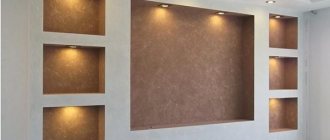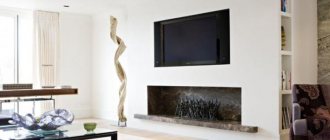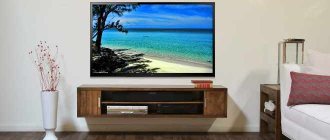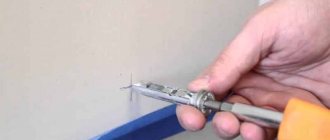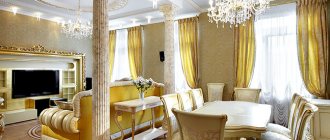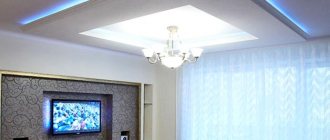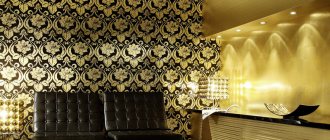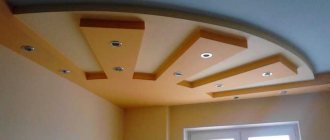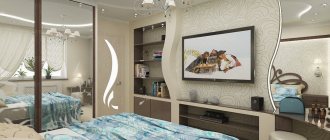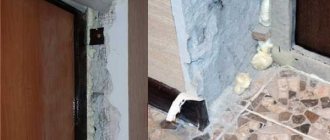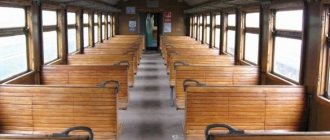A plasterboard niche with lighting will be an excellent design solution for decorating a living space. It can be designed both in a new house and in an already lived-in apartment. The ease of working with gypsum boards will allow you to realize the most intricate designs of the master. After special elastic plasterboard appeared, it became possible to create niches of any shape.
An example of the design and decoration of a plasterboard niche with lighting
The backlight in them can create a soft diffused radiation effect.
Types of lighting fixtures
There is a wide range of lamps for lighting, but only fluorescent, neon and LED representatives are suitable for the design of a niche. In the photo you can see similar samples.
Luminescent
Such lamps are well suited for lighting plasterboard niches, however, they are used infrequently, as they have a short service life. These devices can be used as the main source because they are very bright and do not get very hot, up to 35ºC. For this reason, the lamps are completely safe; they are best installed in apartments where small children are present.
Design option for a plasterboard niche with fluorescent lighting
If such spotlights are chosen, it is best to give preference to closed (silicone) ones.
Neon spotlights
They are more popular, they have a wide color palette, and are used to decorate the interior of a room. The price of such lighting is usually higher than any other, because most often neon lamps are made individually for a given room. The device consists of tubes with neon gas, operates silently and consumes little energy. Even when working for a long time, the devices only heat up to 40º C. The service life of such lamps is at least 10 years.
LEDs
Also widely distributed. Their use will help to beautifully decorate the interior of the room. The operational properties of LED backlighting, its similarity to daylight, allow the lamps to be used for a long time and safely.
Diagram of LED lighting in a plasterboard niche
Most often, bright strips with LEDs are placed in a box with a significant recess.
Which power supply to choose for lighting a niche with LED strip
In the Ledrus online store you can easily find a power supply for any LED strip option. First of all, we look at converters for the required voltage of 12 or 24 V. Next, we calculate the total power of the LEDs, multiplying the rated power of one LED by their number in the segment. Add a margin of 20% and get the required value. Our specialist will be happy to help you and suggest the most optimal driver model.
It is important that power supplies with a power of over 250 W are equipped with a fan, which is quite noisy and causes irritation among residents. Therefore, it is reasonable to buy two less powerful drivers without coolers.
It is necessary to think in advance about the installation locations of the power supplies, as well as the cable route from the 220 V distribution box to the switch and AC/DC converter. It is necessary to ensure easy access to the power supply unit for repair or replacement.
Features of creating lighting in a niche in different rooms
The design of a niche can perform several tasks:
- It will hide various imperfections of the wall plane.
- Replaces expensive furniture.
- Allows you to decorate an unusual interior, imitate a window or other desired object on the wall.
- It will help to visually enlarge the room in size and allow you to decorate it beautifully.
Before carrying out work on arranging a niche with lighting, you need to design the location of the devices. A professional electrician needs to re-equip the wires and determine the coordinates of the sockets for the rational installation of lighting fixtures.
A selection of several options for lighting in a plasterboard niche
The formation of lighting in a plasterboard niche in certain rooms has some features:
- When constructing lighting in a kitchen niche, special attention is paid to the arrangement of lighting. It can be installed both at the top of the model and in the sides of the recess. During family gatherings or receiving guests, such a resource will create a nice homely atmosphere. When deciding to build several plasterboard boxes in the kitchen, they need to be decorated in the same style, with similar lighting. It is also necessary to think about the main lighting lamps; it is better if they emit diffused yellow light;
- Lighting in the living room niche will help create a distinctive personality in the interior. One spotlight will fit a small box, and the sides of the structure can be decorated with mirrors; they will reflect the shining light. In this case, the living room will take on a mysterious look;
Decorating a niche with lighting in the living room - If there is no lighting in the niche located in the bedroom, the plasterboard model will look massive. In addition, such dim lighting can be used as a night light. Soffits in a strip with LEDs have the ability to change color; this property will have a relaxing effect and create an intimate mood. Powerful neon lamps are not suitable here; they are not able to convey a cozy atmosphere.
Advantages of LEDs
Decorating suspended ceilings, niches, plasterboard and brick walls using LED strips is an excellent alternative to conventional lamps, chandeliers and sconces; it can replace wall lighting fixtures. Today, LEDs are among the most popular devices that emit artificial light. Their popularity is due to their design features and advantages:
- low price;
- ergonomics;
- ability to hide functional components;
- ease of installation;
- quick installation;
- the ability to change the location of the LEDs using special glue;
- safety because the tape does not pose a fire hazard;
- LED strip practically does not heat up;
- the flexibility of the tape allows it to be placed non-standardly;
- Decorative lighting can change colors to create a unique and intriguing space.
The LED strip looks beautiful if it decorates a textured brick wall. This lighting fits perfectly into the interior of high-tech and loft styles. The second style is typical for rooms with rough, unplastered plasterboard walls. It is appropriate to use cool LED hidden lighting (ultramarine or emerald shades) in such an interior.
Wooden wall lighting
Textured wall lighting
Illuminated plasterboard wall
Making a niche for a TV
Designs such as niches are also used to place some furniture in the wall. When planning the interior of the hall, owners often think about the possibility of securely mounting the TV broadcaster. A plasterboard niche for a TV would be appropriate here. Such a design will turn an ordinary screen into a decorative element, and will also allow the device to be securely and conveniently positioned.
Original design of a niche for a backlit TV
Even a person with minimal construction skills can handle the installation. By choosing a niche in the wall for a TV, owners will be able to give the room a cozy atmosphere.
How to decorate a wall inside a niche
Any plasterboard construction needs design. It can be ordinary paint or hand-painted - it all depends on the creativity and imagination of the owner.
It is also worth considering that the choice of finishing material for a niche will depend on its functional purpose.
What items are planned to be placed here? If we are talking about technology, for example, a TV, then in order to avoid eye fatigue, the surface should not be too pretentious or distracting.
If a niche is created to accommodate a home library, books and magazines, then it is necessary to choose more practical finishing materials that do not collect dust and are easy to clean.
For a niche that serves as a decorative element, decorated with figurines or valuable objects, the design must be selected accordingly - more expensive wallpaper that attracts attention, Venetian plaster or mirrors.
The niche at the head of the bed can also be covered with wallpaper or covered with decorative plaster.
Wallpaper
The simplest solution would be to decorate a niche with wallpaper. You can choose wallpapers with a similar shade and simple pattern, as well as contrasting or bright ones.
Textile heavy wallpapers with ornate patterns will create a feeling of luxury and chic, while plain ones can become a pleasant accent, adding a certain color to the interior.
Decorative plaster
Good quality plaster will definitely be more practical, and Venetian plaster will also add a touch of luxury. The plaster mixture allows you to create a certain texture, but at the same time remains more resistant to cleaning than wallpaper.
Decorative brick or stone
One of the most relevant solutions today. Brick in a niche will add rigor and brutality to the interior, especially if modern minimalism or loft is chosen as the style.
Mosaic or tile
You should not be of the opinion that ceramic tiles or mosaics are only appropriate in the kitchen or bathroom. This durable and practical material gives scope for creativity to any designer. Glass mosaic or matte porcelain tile with wood texture - you just need to choose the appropriate option for a specific interior.
Laminate or wood
It is also one of the popular solutions when choosing material for decorating a niche. Especially if the interior contains details with the same texture and color.
Mirror
A mirror sheet or tile will visually expand the boundaries of the niche, creating the feeling that there is a continuation of the room behind the wall. Mirrors will look especially advantageous in a niche that imitates a fireplace.
Required materials and tools
After the calculations are completed, drywall tools and materials are prepared. It can be:
Diagram of a plasterboard niche with lighting
- GKL for walls;
- metal mounting profiles;
- necessary lighting devices;
- grinder, drill, hammer drill, metal scissors;
- measuring instruments, building level, plumb line;
- reinforcing tape, perforated corner;
- elements for fastening parts: screws, dowels;
- putty mixture.
Selecting a lamp
Plasterboard ceilings are often made of a combined type. This means that both open and hidden lighting are placed on one ceiling structure. To get such a ceiling, you need to assemble a box and a hidden niche. The following types of lighting fixtures are suitable for plasterboard ceilings:
- Spotlights. They are used to create open lighting. In addition to spotlights, you can use a classic chandelier;
- LED Strip Light. It most often serves as a light source for a hidden niche.
Combined backlight type
In addition, the LED strip in a hidden niche can be replaced with flexible neon or duralight. These lighting fixtures, like the strip, are flexible and can be easily installed in hidden niches, thereby achieving the effect of “floating air”. This effect is created due to the fact that light is reflected from the surface of the ceiling and scattered, thereby creating a soft and diffused glow.
Note! By combining a plasterboard box and a tension fabric using hidden lighting, you can create amazing lighting. The reflection of light is more beautiful from the stretched fabric, which has the appearance of a mirror reflection.
To make the right choice of light sources for hidden lighting, you must be guided by the following principles:
- financial capabilities of a person;
- type of ceiling (single-level, multi-level, figured);
- purpose of lighting;
- installation method (in boxes or niches);
- option for installing lighting elements (by yourself or by a specialist);
- the presence of insulation and sound insulation in the design.
Hidden lighting is used for:
- creating additional lighting in the room;
- creating a certain atmosphere in the room (romantic, fairy-tale, subdued, etc.);
- visualization of certain decorative elements;
- night lighting of the room.
With the right lighting fixtures for your room, you can achieve:
- high-quality lighting of space;
- visual expansion or reduction of space;
- zoning the premises into separate zones (rest, work, eating, etc.);
- exquisite decorative lighting of plasterboard ceiling elements.
Hidden lighting for plasterboard ceilings allows you to solve many design and lighting issues. Therefore, the choice of lighting fixtures for such lighting should be approached carefully.
Stages of work on creating a plasterboard niche with lighting
The wall where the plasterboard niche with LED lighting will be built must be level, large bulges should be removed, and holes should be filled with putty. The video shows the step-by-step process of installing a plasterboard niche with lighting.
Marking
Before installing the structure, you need to draw it on the wall, carefully measuring and marking everything. Markings are also made on the ceiling, stepping back from the wall to the depth of the shelves. Here they make marks for installing the guides. When taking measurements, you need to pay attention to the sinker at the plumb line; it should be positioned freely, without touching anything.
Frame installation
- Metal profiles PN (ceiling guide) 28x27 are attached to the marks located on the ceiling and floor; vertical posts consisting of metal profiles PP (ceiling profile) 60x27 are fixed in them with self-tapping screws.
- Following the measurements of the excavation depth, short pieces of PP are installed horizontally at a distance of 50 cm to connect the structure, checking with a level. This is done so that future shelves rest firmly on these parts of the frame.
To strengthen the external corners, the profiles are connected by forming a comprehensive closed device; for arched, curved lines, a specialized profile is used, and it is also possible to cut the PP 60x27 sidewall for bending along the required contour.
Sometimes a hidden backlight is built, with a border around the perimeter using profile sections protruding beyond the frame.
Open lighting is built after finishing.
Attaching GLK sheets to the profile and installing lighting
Before you make a niche from gypsum plasterboard with your own hands, electric wires for lighting are placed and strengthened in the frame. Drywall elements cut to measurements are attached with self-tapping screws to the inner surface of the niche, to the profile.
An example of a niche frame sheathed with gypsum plasterboard sheets
Using the markings, holes are made for the lighting fixtures, and the ends of the wires are placed there to connect them later. You can make the curved parts of a plasterboard arch in the following ways:
- Roll strips of drywall with a needle roller and wet the surface. The part is bent and attached to the frame, where it dries, taking the desired shape;
- If the bends are small and the drywall is thin, it is enough to bend it with your hands and place it on the frame, attaching it with self-tapping screws;
- Deeper curves can be achieved by cutting strips into parts of the plasterboard structure. Having placed it on the frame, securing it well, the cuts should be filled with putty;
- Then the outer walls surrounding the niche are cut out and installed. When cutting strips, it is recommended to make few joints between the elements.
The process of assembling a curved niche made of plasterboard with lighting.
They must be on the profile; at the place of the cuts, you need to chamfer the plasterboard. The self-tapping screws must be embedded deeper into the material; these places are then carefully puttied.
Further processing of the niche surface
The entire surface of the manufactured plasterboard niche is primed with at least 2 layers, thoroughly drying each one. GKL is treated with starting putty, gluing the corners and joints with reinforcing tape and a perforated corner to avoid cracks. After drying the layers, the final finishing of the product occurs to create an absolutely flat surface.
Plastered surface of a plasterboard niche
Finishing of the model
The types of decorative finishing for a do-it-yourself plasterboard niche with lighting can be very diverse: coating with water-based paint, decorating with wood, plastic, wallpapering and much more, which will be preferred by the owners of the room.
Plasterboard cladding
Before installing the gypsum boards, electrical wiring is laid, placing it in cable ducts or fireproof corrugations.
The gypsum board sheet is cut into suitable fragments.
Mr. Build recommends: take the required dimensions from the frame, not from the drawing. During the installation process, changes in the dimensions of the structure are possible, and if the measurements are incorrect, the pieces of plasterboard do not fit together.
The cutting is carried out as follows:
- Marking lines are applied to the plasterboard.
- A paint knife is used to cut through a layer of cardboard on one side of the sheet, after which it is carefully broken and turned over.
- The top covering is cut through on the second side (as in the picture).
- The cut is processed with fine sandpaper. If a joint of fragments is planned in this place, then using a special plane a chamfer is made at an angle of 45˚.
- Sheathing begins from the inside of the niche. Fragments lying in perpendicular planes are mounted so that one element covers the end of the second.
- The drywall is fastened with self-tapping screws in increments of 25–30 cm, slightly recessing their caps into the material. When using a special bit, the risk of damaging plasterboard sheets is minimized.
- Special corners are attached to the outer corners of the structure to protect the fragile drywall from damage.
After cladding, the surface is prepared for finishing:
- The seams are glued with fiberglass reinforcing mesh and covered with putty. The rules for processing seams are described in detail here.
- After the putty has dried, they are rubbed down with fine sandpaper.
- The entire surface of the niche is treated twice with a universal primer. After applying the first layer, wait until it dries completely, and only then apply the second.
- The last stage is puttying the entire structure using standard technology. If the niche will be tiled, putty is not needed.
Connecting the backlight
As already mentioned, all electrical wiring under the drywall is installed at the stage of assembling the frame from the profile. Its ends need to be brought out and the niche covered with plasterboard. Backlight installation steps:
- First, closed-type lamps are installed, connecting them to the wires. These can be special devices with silicone filling, their heating temperature does not exceed 35 ͦ C;
- Installing a strip with LEDs requires the presence of a power supply, which is placed inside the niche.
LED bulbs located on self-adhesive tape will come in handy. It is mounted on the wall inside the niche or placed as indicated in the project. To direct the flow of light into the recess, a side is constructed using a starting profile or a piece of drywall. It is sealed with plasterboard, plastic or metal overlays; - Neon tubes are also equipped with a side;
- Spotlights are placed in the prepared openings of the box. Their contacts must first be connected to the wires.
The photo shows examples of niches decorated with several types of lighting. In this regard, a specialized inverter for generating electricity must be equipped at the bottom of the structure, hidden behind the drywall. When making a plasterboard niche in a wall using lighting, you must have certain knowledge, which can be obtained from a specialist.
Design highlight: LED lighting of wall and ceiling niches
People familiar with modern lighting technology are well aware that there is no alternative to LED strip to create a design using lighting. However, this is not at all obvious to ordinary buyers who want to put lighting in indoor niches into practice.
We answer the most common question from our customers: why is it better to use an LED strip to illuminate a ceiling niche? We emphasize that the feasibility and benefits of this solution are based on the real advantages of the LED strip:
- the only option for creating a continuous strip of light;
- minimal energy consumption;
- ease of installation;
- minimum maintenance;
- self-sufficiency of execution - application without any modifications;
- choice of any length - cut from a roll and installed;
- management flexibility;
- any color and shade options.
The power of the LED emitters on the strip is sufficient to illuminate individual areas of the room, its perimeter or the entire room. The correct choice of the type and density of LEDs on the strip allows you to realize your wildest fantasies and design solutions.
A selection of photographs of decorated plasterboard niches with lighting
Popular options
The most popular options for masking lighting fixtures is installing a niche or box. Both options are suitable for multi-level plasterboard ceilings. Note! The box and niche do not require large sizes. It will be enough to create a narrow structure to hide even an LED strip with all its accompanying elements (controller, power supply).
The advantages of such design solutions are:
- The range of selectable lighting devices, which may become slightly warm during operation, is significantly expanded;
- allows you to install larger lamps, as the structure is strong and rigid;
- installation of lamps can be carried out to the profile itself;
- installation of the box will allow you to hide all the unevenness of the main ceiling, as well as communication means (wires, additional lighting equipment, etc.).
Note! If the LED strip is connected to a controller, then it is possible to create a controlled lighting system.
For hidden lighting, installation of the box and niche occurs according to the following scheme:
- the box is installed using guide profiles that are installed around the perimeter of the room;
- We raise the box to height using rack profiles cut into lintels;
- We connect all the profiles together with screws, and with the walls with dowels;
- Then the rack profiles are connected by guides. The result is a metal box frame;
- after that we run wires for lighting in the frame;
- then we cover the structure with plasterboard sheets.
At this stage, forming a niche involves installing the bottom sheet of drywall approximately 8-12 cm wider than the frame of the existing box. It is on the protruding part of the material that light sources should be placed. On such a niche you can place an LED strip, duralight or flexible neon.
This design will look beautiful in almost any room of the house.
Note! Some experts do not recommend this solution for the kitchen. This is due to the special microclimate of this room. To ensure that the box or niche lasts in the kitchen for as long as possible, use moisture-resistant sheets of plasterboard.
The disadvantages of this design solution include:
- these are quite time-consuming and physically labor-intensive structures;
- if the installation technology or final finishing is violated, cracks and chips may appear on such a ceiling within a few years;
- The work should be carried out together, since sheathing the ceiling with plasterboard sheets alone will not be very convenient.
Problems here may arise at the stage of installing profiles at the same level and cutting the material.
